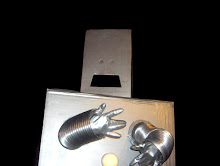 Building a personal brand and using a machine to humanize you? A blog, as well as your portfolio? My portfolio is the greatest thing in the world. It showcases my experience, increases genital size and cures diabetes, but that doesn't automatically entitle me to a flood of return traffic and new business.
Building a personal brand and using a machine to humanize you? A blog, as well as your portfolio? My portfolio is the greatest thing in the world. It showcases my experience, increases genital size and cures diabetes, but that doesn't automatically entitle me to a flood of return traffic and new business.
A portfolio is stagnant, lazy, and unadored. A blog, on the other hand, can be interesting, personalized, and compelling. It's the perfect tool to fill the interest gap, and the hoped-for side effect is peripheral interest in your work after admiring your carefully crafted thoughts, then comes love, then comes marriage.
It's a silent interview
Human psychology 101: it's harder to hate people you know than random strangers. You want the world at large to love you, and you want that love to translate into increased business. But unless you're the Caligula of cold calling, you're not going to be meeting people and you're not going to be making great contacts. Your blog is a museum of you, and it's open twenty-four hours. Show off your abilities by sharing your knowledge. Show your value by having the maturity to put it all out there for the world to enjoy.
you're waiting for people to reach you, and a blog is the perfect place for you to create a museum of you, to share your knowledge and show your abilities. In short, it's the pre-interview you.
Getting to know you
As an Art Director and Graphic Designer, I could drive a car through an Adobe seminar and I'd still have 99.99998% of the competition able-bodied and hacking at that same pie (they're out there, while I'm in prison). A potential client has a lot of choice when it comes to making a hire, and without the benefit of a living conversation to add substance to your name, you're a ghost. A simple portfolio can't tell them what you might have in common; there's no chance to be impressed by your opinions and mindsets, to enjoy your wacky experiences or to relate to you on a more personal level. All of this can translate into the trust and confidence that might see you with a new business card.
I know, it's a big ass crowd
The theory bouncing around is that as more people recognize your name through social networking (blog, twitter, facebook, flickr, linkedin, etc) the more leads and referrals to follow. Don't automatically hang your hat on this nail. It's a big web out there. There's a better idea...
Give away your cow's milk
Create your blog, and focus your writing on what you know best, then squeeze. Honesty reads, and the need to feel like every other blog out there is not the most satisfying past-time. Write what you know, as long as it's unique and credible. It may seem counter-intuitive to spill your guts to the world and share valuable revelations and experiential tips for free, but if you believe in karma or wiki-spiritualism, you'll end up benefiting long-term from relationship building, networking with your peers, and increased business.




















